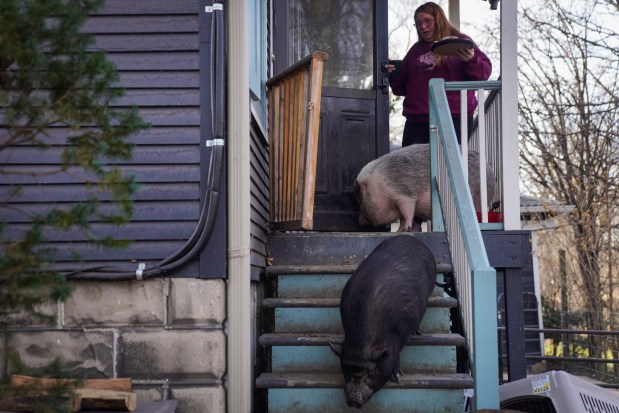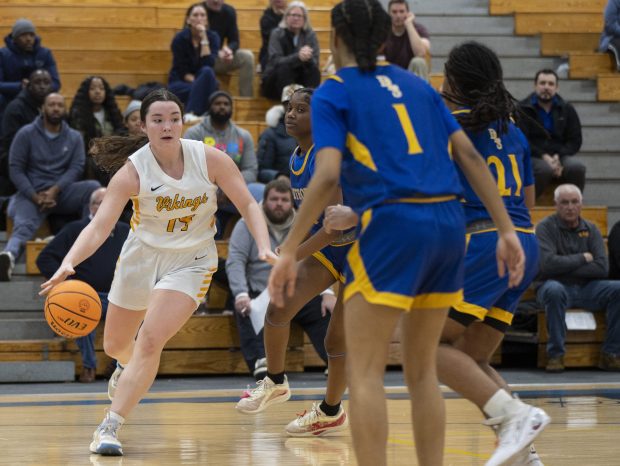April Noga had two days to prepare for this rescue mission — save 18 pigs from a petting zoo in northeastern Illinois.
The 36-year-old had a pet pig of her own and had rescued pigs before, but she had never done a rescue mission of this scale.
“I was like, ‘OK, if I’m gonna work on this case, no pigs left behind. I’m going to somehow figure out how to do this all and get all these pigs out,” Noga said. “I didn’t sleep, didn’t eat…all I was doing was networking and hopping online and practically asking the pig community for help.”
With little time to spare, Noga and a few others headed toward the petting zoo in June 2020, having rented a moving van to help transport all 18 pigs. As the rescuers spent hours rounding up pigs in the blazing hot sun, Noga noticed an extra seven pigs on the property she had not been told about. Without hesitation, she eventually returned to the petting zoo to save them.
She later found out those extra seven were pregnant, bringing the total number of pigs she rescued up to 42.
Since then, Noga has traveled thousands of miles to rescue and rehome pigs all over the Midwest and beyond. In the summer of 2020, Noga and her husband started Chicagoland Pig Rescue, the only nonprofit in the Chicago area dedicated to rescuing, fostering and transporting pigs across state lines. The organization, funded primarily by donations, has saved over 300 pigs through its network of foster partnerships throughout the Midwest.
“There’s not as many sanctuaries as there needs to be to meet the need,” said Phoebe Conner, co-director of Chicagoland Pig Rescue. “But there are sanctuaries — farm animal sanctuaries — in every single state and I think a lot of people don’t even realize that.”
Illinois has about 20 farm animal sanctuaries, according to Conner. They will usually take in animals and keep them on their property to live out the rest of their life, which means there is not always enough room or resources for every animal that needs to be rescued.
“Sanctuaries are just bursting at the seams, unfortunately, because the need is so high with rescuing animals, especially farm animals,” Conner said.
That is where Chicagoland Pig Rescue’s foster-based system steps in to fill the gap. The nonprofit relies on a network of volunteers to help with everything from transporting pigs across state lines to providing pigs veterinary care and a temporary home until they are able to move into a more permanent place.
How it works
Chicagoland Pig Rescue typically gets anywhere from 10 to 20 phone calls a month with pig rescue requests, according to Conner. The reasons why a pig needs to be rehomed can greatly differ.
There are “truck jumpers” — pigs that have fallen or jumped out of vehicles (and who hold a special place in Noga’s heart). There are people going through a divorce or about to lose their home and need to find a new place for their pet ASAP. There are pigs in hoarding situations or being used for farms and petting zoos. But no matter the circumstance, one element seems to stay consistent — the situation can become a matter of life or death very fast for the hoofed creature.
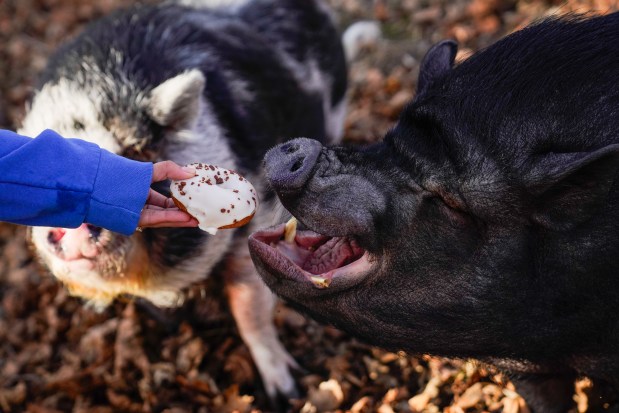
“The stakes are always really high with pigs,” said Chess Valenti, a volunteer with Chicagoland Pig Rescue. “It’s usually something traumatic and dramatic that’s going on and so the call that we always get…is, ‘Hey, I’m gonna shoot my pig,’ or ‘I’m going to give my pig up.’”
Unlike dogs or cats, pigs can’t be easily given to relatives or friends, and finding animal shelters for pigs is nearly impossible, which means volunteers often are scrambling to pick up the pig and find a solution to the problem.
“So it’s like I either go get that pig or that pig dies, and that can weigh really, really heavily,” Valenti said.
That was the case for Maxwell, a nearly 500-pound orange and white pig that was supposed to be slaughtered for meat by a family until Chicagoland Pig Rescue stepped in.
“Their adult daughter really advocated for him and saved him,” Noga said, noting that the daughter was begging her organization to rescue the pig. When Chicagoland Pig Rescue arrived, Maxwell was belly-deep in mud, urine and feces. When the time came to transport him out of his home, Noga said Maxwell took up nearly every inch of the moving van, but that didn’t stop them from driving him to his vet checkup and eventually to his new home at an animal sanctuary in Michigan.
“He was just the happiest, most playful and amazing pig,” Noga said. “I identified with the girl who stood up in front of her family and said ‘No, you’re not going to kill him.’ It’s a really important lesson to other people — if you see an animal in need, you have the opportunity to stand up for them.”
Those are the types of people who help keep Chicagoland Pig Rescue going. From lifelong dog owners like Ann Shorrock to people who discover the organization online like Valenti, it’s the ordinary people who are willing to take a chance and make a difference in a pig’s life.
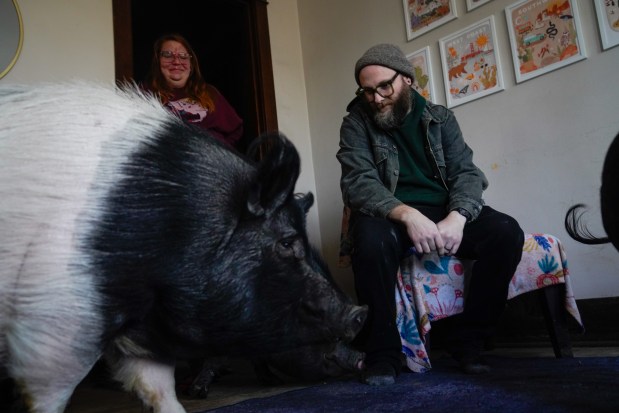
“I’m always working through my lunch periods. If I don’t have something to do for school, I have something to do for rescue,” said Conner, who works as a special education teacher for Naperville North High School. “Usually right when I get off of work my nights are spent either doing work that I have to do as a teacher or work that I have to do for our rescue.”
The opportunity to not only save the pigs, but also to get to know the pigs and help out other sanctuaries involved, has also been life-changing for everyone involved.
“I stopped eating meat and I went vegan,” said Noga, noting that prior to owning her first pig she did not know if she could go vegan. “When you’re living with these animals day to day, and they are literally a part of your family, and you learn about the conditions in factory farms, it’s a huge thing to feel like you’re not contributing to that.”
But taking care of the pigs is also no small feat. Valenti, who has fostered several pigs over the past three years, said loving a pig is about loving them for who they are. While dogs will lick their owners and show affection, she said pigs will often take love from their owners but will not always reciprocate it.
“It’s like loving your toddler, because pigs are so much like toddlers,” Valenti said. “You really have to appreciate the personality of pigs, because they’re stubborn and they’re loud and they will complain and they won’t give up till they get what they want.”
For Valenti’s current foster pig, a black and white potbelly named Arnold, that means screaming around 5 p.m. demanding to be fed for dinner time or digging up acorns buried by squirrels in the backyard.
Luckily, if there are any questions a foster parent may have, Noga is just a phone call away to help out with anything. “It really is like a 24-hour-a-day operation,” Noga said.
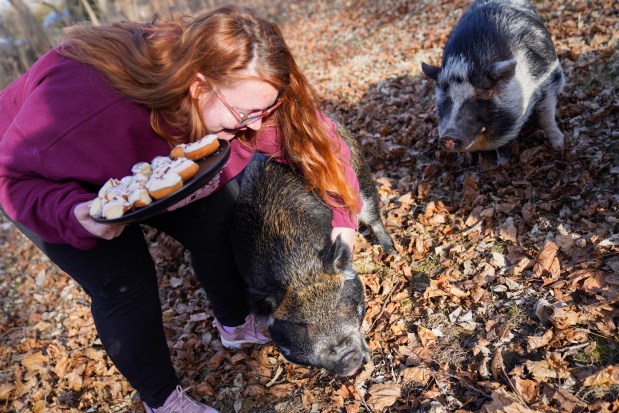
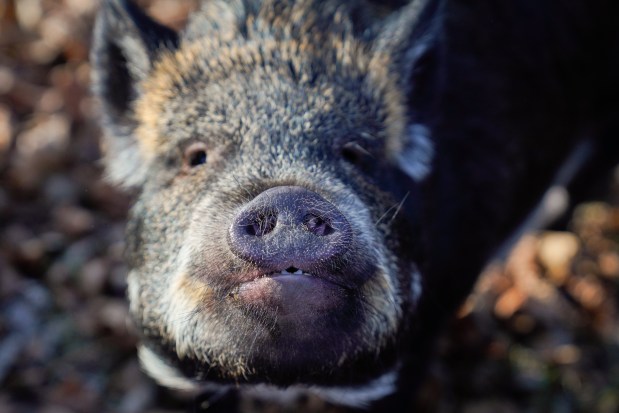
That operation even includes helping out other sanctuaries whenever possible.
“I have gone on work trips where we went down to a sanctuary down in central Illinois to help build fencing,” Shorrock said, noting that the sanctuary had just rescued a few pigs and needed fences built for them. That involved Shorrock and a few others pounding posts in the ground, putting up heavy metal fencing and twisting metal ties together.
“It’s cold and it’s very gratifying, but it’s hard work,” Shorrock said. “Obviously, it would be great if there was funding for these things, but there’s not. So it’s just people and sweat and a lot of hard work. A fence like that could probably be put up by a company in two hours. It took us, you know, the better part of two weekends to get it done. But that’s kind of April and Phoebe — they just do the work.”
As for continuing that work, Conner hopes there eventually comes a day when Chicagoland Pig Rescue is no longer needed. For now, she and Noga will continue to do all they can to educate people and grow their organization.
“Our long-term goal is to get acreage and to have a big, full pig sanctuary and hundreds of acres; that’s like our dream,” Noga said. Until then, she will continue to do what she can as an ordinary person from the south suburbs.


